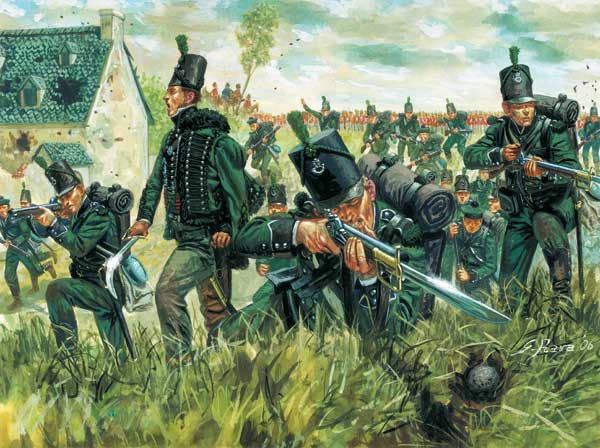95th Rifles - A brief history.
 •
by
•
by Pat Harper

In 1800 The Experimental Corps of Riflemen was formed, eventually becoming the 95th (Rifle) Regiment of Foot in 1803.
Riflemen were different, in many ways, to the soldiers that made up the bulk of the British Army. Instead of the classic 'redcoat' and white crossbelts worn by most infantrymen, the Rifles wore a distinctive 'greenjacket' and black leatherwork. This was the first attempt at camouflage by the British Army and was a reflection of the very different role expected of this brand new soldier, who was encouraged to make use of his surroundings.
Of course the other most notable difference between a Rifleman and most of Wellington's Redcoats was the weapon he carried, the Baker Rifle. Redcoats were generally issued with the 'Brown Bess' musket, capable of wavering accuracy at 75 yards. The 'Baker' was able to hit a man-sized target 200 yards away, and there are legendary characters within the regiment such as Tom Plunkett who achieved accuracy at 400 yards using a Patched Ball. This accuracy was down to a combination of the weapon and a revolutionary new training initiative.
Training & Ethos
The first Riflemen were selected from the cream of the army and brought to Horsham, where they began to learn their trade. Schooled in the art of skirmishing, a Rifleman was encouraged to push the enemy on his own initiative, using aimed fire to harass and defeat his foe. Deliberately aiming a weapon was a new concept to the British infantryman. A traditional soldier, armed with a musket, did not aim but merely pointed, or ‘presented’, his musket in the direction of the enemy as, unlike the Baker, it was not an accurate weapon.
It wasn't just the content of the training that was radically different but the approach. For example, Riflemen regularly trained with live ammunition (a luxury in the British Army at the time), giving them the opportunity to refine their shooting skills. Shooting competitions and similar competitive activities where conducted within the regiment, a practise that came with rewards and merit.
Individuals were recognised as individuals and not just a body of men. An eager Rifleman showing potential would be invested in. If he could not read or write he was taught, to give him a better chance of promotion.
The social barriers that existed in society were not as much of an issue in the 95th, perhaps because Officers shared the same fate as the lower ranks, often sleeping rough on the countless patrols and picket duties they were deployed on. Officers would regularly dine with their men and get to know them, a practice that was unheard of at the time.

On Campaign
On campaign the Rifles were masters of the battlefield and second to none when it came to skirmishing in particular. They were held in high esteem by the French and Allies alike. One officer, Major John Blackiston of the Portuguese Cacadores, sai
😛
"I never saw such skirmishers as the 95th. They could do the work much
better and with infinitely less loss than any other of our best light troops.
They possessed an individual boldness, a mutual understanding, and a
quickness of eye in taking advantage of the ground, which, taken altogether,
I never saw equalled. They were as much superior to the French voltigeurs,
as the latter were to our skirmishers in general"
The Rifleman's speciality was targeting enemy officers, NCOs and drummers, the loss of which could cause disorder and panic amongst the enemy ranks. Their skills were also used to eliminate artillery crews, as the range the 95th could engage such targets at allowed them to do so with minimal losses.
The 95th were more than just skirmishers though. They earned their reputation as a ‘universal soldier' by playing their part in sieges like any other Infantryman in Wellington’s army, storming the breaches at Cuidad Rodrigo, Badajoz and San Sebastian.
All three battalions of the 95th fought together for the first time in the closing weeks of the Peninsular War at the Battle of Tarbes, where the regiment independently swept the forces of General Soult from the path of Wellington’s army as it advanced into France.
The Rifles served throughout the Peninsular War in Spain and Portugal, seeing action in many battles like Bussaco, Salamanca and Vitoria. They saw action in America during the War of 1812, and of course oversaw the downfall of Napoleon at the Battle of Waterloo in 1815.

Legacy
The Regiment remained the 95th (Rifle) Regiment of Foot until 1816, when they were renamed The Rifle Brigade in honour of their achievements during the Peninsular and Waterloo campaigns. The Rifle Brigade then became the Royal Green Jackets in 1968, amalgamating with the 43rd and 52nd (former redcoat regiments of the Peninsular War ‘Light Division’) and the 60th. The Royal Green Jackets amalgamated once again in 2007 with the Devonshire and Dorset Light Infantry, Royal Gloucestershire, Berkshire and Wiltshire Light Infantry and The Light Infantry to become The Rifles.



Comments
V+S 🙂)
Good luck in writing!